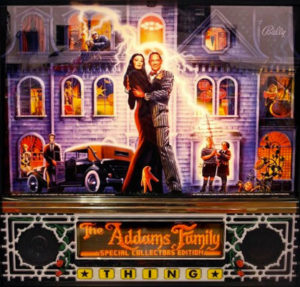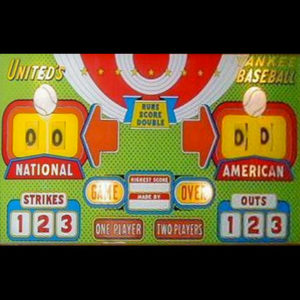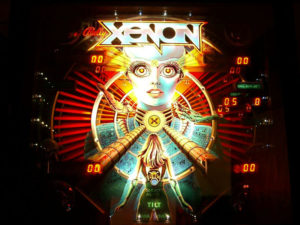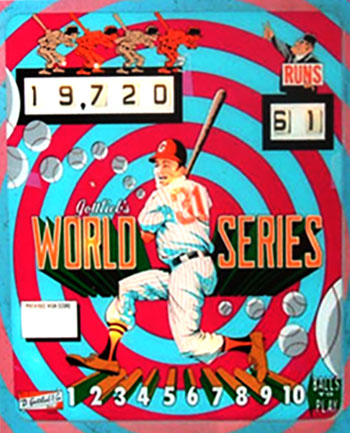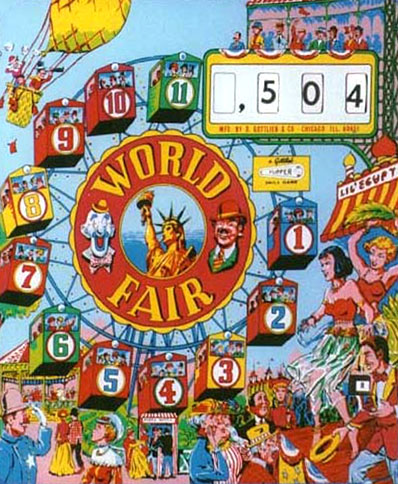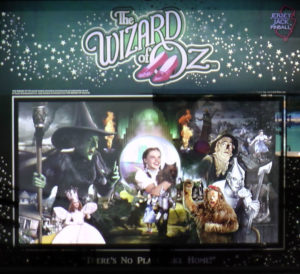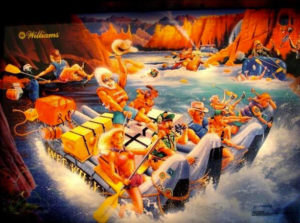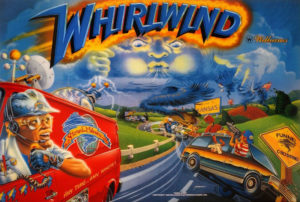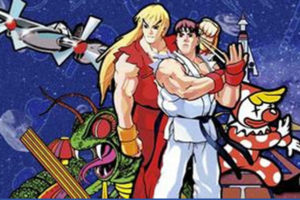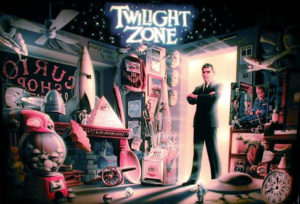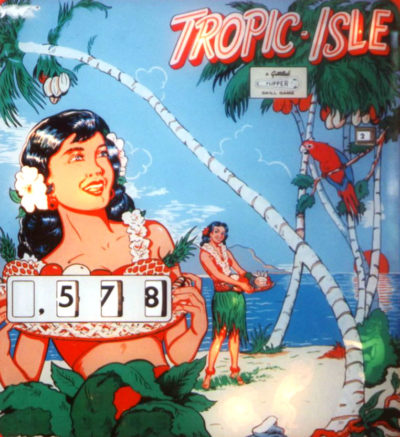-
This “special edition” game was produced to recognize the fact that this game, when initially released two years earlier, was the biggest number production game ever made in the contemporary era, with a total production run of 20,270. This game was produced in 1,000 examples. Pat Lawlor designed the machine with John Youssi getting accolades for the artwork. Gadgets abound in this machine, which is augmented by the gold detailing over the standard unit. The main theme here is to complete all 12 parts of the house panel. Doing so brings you to the ultimate level of excitement. Multi-ball options abound as well as “Thing”, consisting of just a hand, grabbing the ball in the upper-right corner of the machine. A magnet under the play field provides strange ball play as well as Thing “flipping” the ball remotely if hit. The sounds and art are fantastic representations from the movie of the same name. This game is #3!“Welcome to Xenon” announces the machine when you coin it up. This is the first game to incorporate a female synthesized voice as its main character. Bally produced 11,000 of these sexy, colorful games. It was designed by Greg Kmiec with art by Paul Faris. This is also the first time a game has a “vocalizer” board installed in it. Prior to this, a “squawk and talk” system was used. Finally, you can really understand the game! The playfield incorporates a right-side Xenon transport tube, which, when shot and conditions are met, lock the ball. An upper saucer at the top of the playfield not only drops one of four drop targets when rolled over, but advances the “X” value. Making three “X” completions lights the lock. The second time around awards a two-ball multiball extravaganza. Drop targets, when all four are completed, advance the bonus toward specials also. The moto exit value increases the more times the transport tube is made. A great package!Gottlieb produced a few baseball-themed games, but Williams Manufacturing was the king of these types of games. This game, designed by Ed Krynski with art by Gordon Morison, had a run of 775 units. This is the add-a-ball version of this game, so it is rarer. The replay version is called Grand Slam. This game has eject holes which activate the roto-target, a Gottlieb exclusive device, which stops and a man is lit on a corresponding base to the eject hole on the baseball diamond. The rollover button lights when the bases are loaded. This scores 1,000 points whenever the bases are loaded. Runs and score are the ways to win free balls with this game.This classic game is currently rated as the number two game of its generation. 4,650 units were produced in April of the year with design credits going to Roy Parker for artwork and Wayne Neyens for design. The game was produced to coincide with the New York World’s Fair of 1964-1965. The 11 ferris wheel cars depicted on the backglass are represented on the play field by roll overs and targets. Hitting a numbered car lights the corresponding backglass car. The interesting gadget developed for this game is the center spinning disc (i.e. ferris wheel) in the middle of the game. By spinning the disc, one randomly spots a ferris wheel car on the backglass. Completing all the cars awards a replay and the randomly advancing lighting of a rollover which, if you’re skilled enough, would award a replay if hit. Score is another way to conquer the machine. Enjoy trying your hand at this classic machine.Wow! What a light show! The machine before you represents the first offering from the fledgling company of Jersey Jack Pinball of Lakewood, N.J. A pinball of any production hasn’t been made in the state for decades. This machine was created as a centerpiece of technology to show the arcade world what a contemporary machine can contain in one package. Stern, the only other U.S. maker of pinball, has always streamlined the process of pinball manufacturing and kept the number of pinball “toys” on a machine to a minimum to make their machines less expensive. Since this machine came out, Stern now offers three models of their newer machines: a stripped basic unit, an average machine contents wise and a tricked-out collectable unit to compete with the likes of Jersey Jack. Look at this machine! Mike Balcer designed the playfield; Jerry Vandersteldt, Greg Freres and Matt Riesterer penned the artwork. 1,000 units are already spoken for and both a special edition (the one here) and a standard edition are planned. Five flippers, five magnets, color changing LEDs, a 26-inch LED monitor, shaker motor, ball lift, spinning house toy, crystal ball projector, rising witch and wide-body package are only some of the innovations seen here.White Water is a 1993 pinball game designed by Dennis Nordman and released by Williams. The theme is based on White water rafting, which is reflected in the game’s ‘wild’ ramps and very fast gameplay. Overview White Water is a non-licensed pinball machine with a primary objective of moving your raft down the river to “Wet Willy’s” in order to get the “Vacation Jackpot.” You move your raft down the river by shooting the flashing “Hazard” shots, each with a unique rafting theme name. Each time you complete a raft, the number of “Hazard” shots you must hit successfully to complete the next raft increases. It takes eight completed rafts to advance to “Wet Willy’s.” Successfully completing “Wet Willy’s” enables the player to attempt the collection of the “Vacation Jackpot.” There are subsequent objectives in the game, which include: Multiball: To start multiball, light the lock ball shot by hitting the “Lite” and “Lock” targets and then successfully shooting the ball in the ball lock, also called the “No Way Out” Hazard; doing this 3 times will start multiball. Whirlpool: Completing the “Whirlpool” shot will activate one of six awards or modes, which is determined by what is lit when the “Whirlpool” shot is hit. To light the “Whirlpool”, thus making the shot active, successfully hit the “Insanity Falls” shot. After hitting the “Insanity Falls” shot, you will know the “Whirlpool” is active when the red light above the shot is lit. One of the six awards or modes starts when the Whirlpool shot, also called “Bigfoot Bluff”, is successfully competed. Big Foot Hotfoot: There are two “Hotfoot” targets in the middle of the playfield. Hitting both targets comprises a complete “Hotfoot”, and the “Hotfoot” targets are reset. Depending on the machine settings, successfully completing the specified number of “Hotfoot” targets starts the “Bigfoot Hotfoot” mode which allows the player to get successive “Bigfoot Jackpots.” Lost Mine: Hitting the ball in the “Lost Mine” shot awards an item needed to start the “Gold Rush” multiball. There are three items that must be collected to start this multiball, a flashlight, a map, and a key; and these items can be collected through either the “Lost Mine” or the “Bigfoot Hotfoot.” Once all three items have been collected, successfully hitting the “Lost Mine” shot starts the “Gold Rush” multiball.This machine was produced in january and 7300 copies of it were bolted together. Pat lawlor designed the game with john youssi penning the artwork. The earliest machines in the production run had the chicago cubs logo on the child’s baseball cap but the cubs disallowed its use so the logo was changed. The early examples had a williams logo sticker over the cubs logo. The object of the game is to advance the compass to the north, south , east and west positions. Doing so starts ball lock ..And the “power of the wind” through the use of a dedicated fan on top of the machine to recreate a new physical dimension to your gameplay. Once three balls are locked, the left ramp awards increasing million awards. By earning enough tolls, extra balls may be had. The super cellar value changes via the spinner. Dropping into the cellar awards its value. Another “twist“ in the game’s design is the spinning discs. Tornado action.This one or two player upright video game is not just one dedicated game like Pac-Man or Missle Command. Through the use of modules or packs installed in the machine, more games could be added to its itinerary of playable classics. Early video games had full circuit boards within the machine as well as dedicated transformers and controls. Nowadays, emulators have taken over the arcade and home markets, allowing thousands of games in the footprint of one machine. Pinball machines have also been emulated in this formats. These games are finding themselves more and more in the home market for obvious reasons: you can have 100 of your favorite machines to come home to in one solo unit–and you own the keys!This game is the most complicated solid-state pinball machine for complexity and gadgetry ever made. 15,235 of these were made and design credits go to Pat Lawlor with art by John Youssi. Multiple multi-ball options, magnets, a porcelain power ball a gumball machine and an extra-wide play field are only part of what’s before you. The main object of the game is to complete all the segments of the door in the bottom of the play field. These segments illuminate a light in the door. If by rare chance you complete the feat (you can “buy in” extra balls at the end of your game), all heck breaks loose in the form of a “lost in the zone” ultimate stage in the game. All six balls pop out, every option special, and bonus is lit all at once, and then, as if by magic, the flippers stop working (as this is a timed event) and your bonus is totaled. The battle in the zone magnet-controlled play field and power ball are neat!Wayne Neyens designed this classic with Roy Parker penning the artwork. 2,700 of these were fabricated. This game has a holdover feature, which holds the monkeys’ positioning on the backglass from game to game. If you’re skillful enough to hit the A, B, C, and D targets, a monkey is advanced up the tree on the backglass. If one monkey makes it to the top, one replay is awarded: two monkeys score two replays, and three monkeys score three replays. Obviously if you pass this game and notice the third monkey nearing the top, feeding the coin slot was a natural for your just reward. Rolling over the 1 – 5 rollovers at the top of the playfield lights the side specials and awards 200 points once you drain the ball. A nice, well balanced game and quite a challenge not to lose your ball in play.
-
This “special edition” game was produced to recognize the fact that this game, when initially released two years earlier, was the biggest number production game ever made in the contemporary era, with a total production run of 20,270. This game was produced in 1,000 examples. Pat Lawlor designed the machine with John Youssi getting accolades for the artwork. Gadgets abound in this machine, which is augmented by the gold detailing over the standard unit. The main theme here is to complete all 12 parts of the house panel. Doing so brings you to the ultimate level of excitement. Multi-ball options abound as well as “Thing”, consisting of just a hand, grabbing the ball in the upper-right corner of the machine. A magnet under the play field provides strange ball play as well as Thing “flipping” the ball remotely if hit. The sounds and art are fantastic representations from the movie of the same name. This game is #3!



